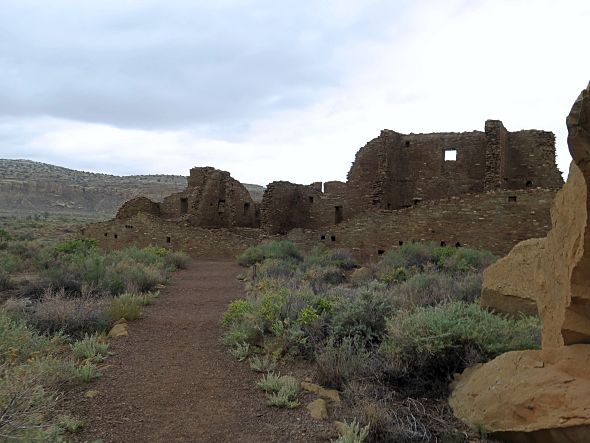
I like to look at maps. Always have. As a kid I would sit with an atlas for hours.
Now, later in life, my affinity for cartography helps me discover places to visit that I may have never learned about without it.
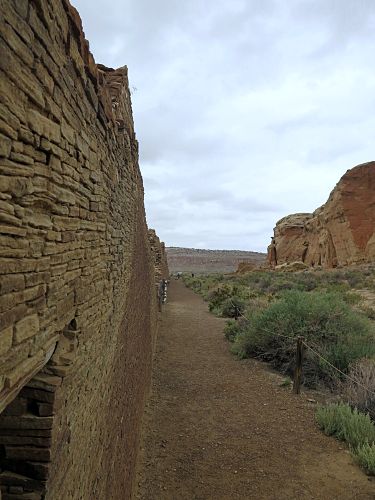 One such instance happened a few months ago. I was scanning a map of New Mexico for no apparent reason and noticed a place I was wholly unfamiliar with, Chaco Canyon. The Chaco Culture National Historical Park to be exact.
One such instance happened a few months ago. I was scanning a map of New Mexico for no apparent reason and noticed a place I was wholly unfamiliar with, Chaco Canyon. The Chaco Culture National Historical Park to be exact.
One of the first things I noticed was the lack of any roads leading to the park. As I zoomed in a few local dirt roads began to appear, but this is without a doubt one of the most remote and inaccessible locations in the entire National Park system. But don’t let that discourage you, because this is also one of the most important pre-Columbian historic sites in the United States.
And don’t get the wrong idea, it is certainly possible to get there. A truck or SUV is definitely preferable, but weather permitting, a car can make it. And after an hour or so of bouncing along a rough dirt road the payoff is definitely worth it.
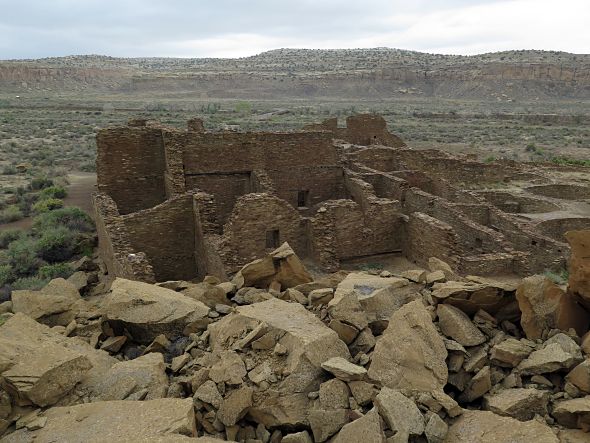
The ruins at Chaco Canyon offer remarkable insight into the lives and culture of the people who populated the Four Corners region over a thousand years ago. Artifacts found here reveal a society that traveled and traded from Central America to the Pacific Ocean.
It is also very clear that these people were very skilled builders. The construction and architecture is much more advanced than we expected to find. These are massive, up to five story buildings with very precise designs and stonework.
By studying the structures, especially noting the abundance of kivas, archeologists have developed significant theories as to the lifestyle, traditions, and way of life of this highly developed society.
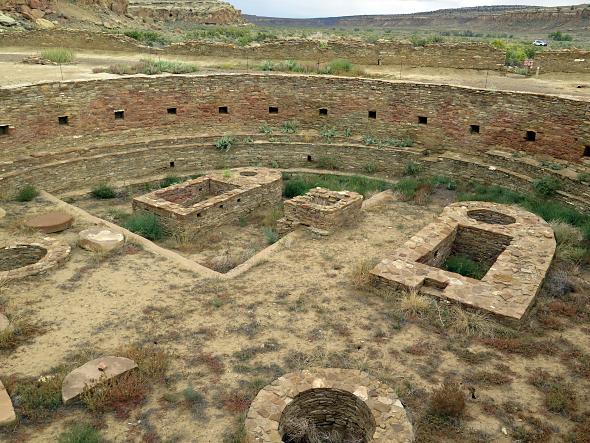
Kivas are circular, ceremonial rooms that vary in size from just big enough for a handful of people to meet or celebrate, to large enough for dozens, if not hundreds to participate. With about forty kivas at Pueblo Bonita at Chaco Canyon, it looks as though this was less of a home for many people and more of a ceremonial meeting place for hundreds, if not thousands, of visitors from across the region.
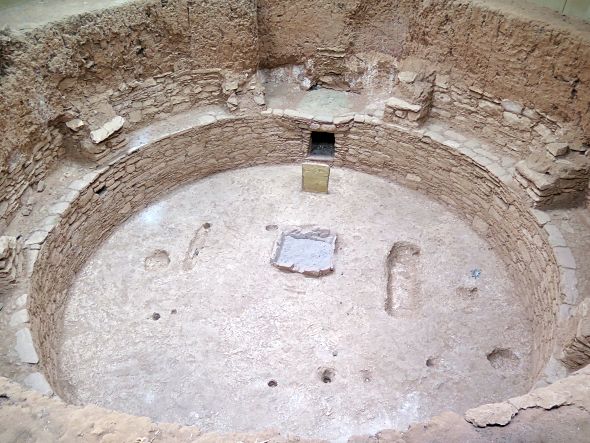
Chaco Canyon was the predecessor to several other nearby ancient communities, most notably Mesa Verde and Aztec Ruins, that were built as of the Ancestral Puebloans moved north. As soon as we learned that bit of information we knew that we had to visit those sites as well.
Aztec Ruins National Monument is about fifty miles north of Chaco Canyon, actually in the town of Aztec, New Mexico. The name is terribly incorrect, no Aztecs were ever in the vicinity. It stems from the Spanish explorer’s habit of labeling almost anything to do natives as Aztec.
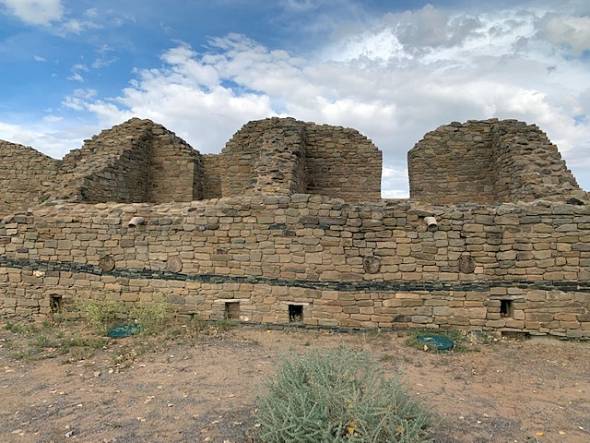
These ruins are a bit newer than those at Chaco Canyon, and we could see that the construction quality had improved. We were especially intrigued by a decorative stripes of green slate that were included in some of the walls.
There is also a fully restored kiva at the site, which is very impressive. In 1916 archeologist Earl Morris came here to begin excavation work. Almost twenty years later he oversaw the reconstruction of the Great Kiva.

Another fifty miles or so to the northwest brings you to Mesa Verde National Park. We had visited the Park in the past, but now we were able to see it with a much better understanding of what happened here.
It is the most recent of the three sites, with the cliff dwellings that we see now having been built from around one thousand to eight hundred years ago. By the late 13th century about twenty thousand people were living in the community, but by the end of the century there was almost nobody left.
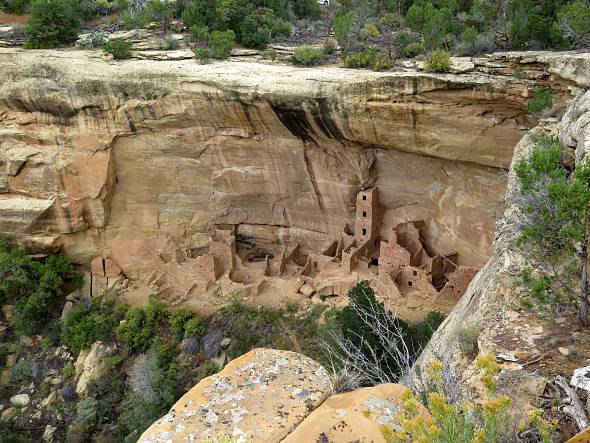
However, the people living at these settlements did not simply disappear. They did leave rather abruptly, but the evidence shows that they moved to other areas.
Theories as to why they did this have been bandied about for decades. The timeline has been very accurately determined by dating the tree rings on the timbers that were used in the construction. So, it is known that around the year 1300 the residents of these pueblos packed up and left.
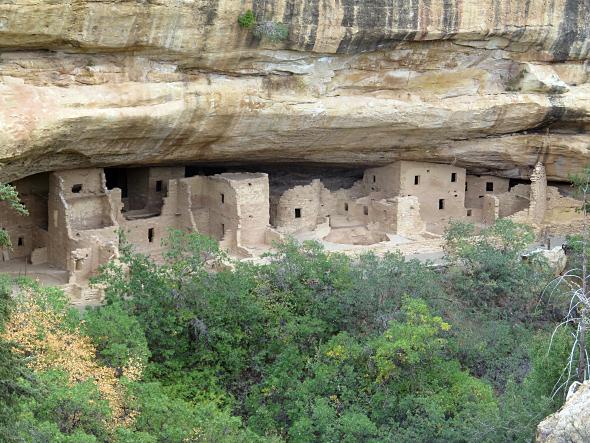
It is also known that a severe drought hit the region beginning around twenty years before the departure, so it is reasonable to surmise that lack of water, and all of the problems that come along with it, were a major factor in abandoning these dwellings. Yet the fact remains that with no written record left behind we may never know the whole story.
While researching these sites, we found that a great deal of what we thought we knew about this area was likely misunderstood. First and foremost being the name that we, and most everybody else, have used to describe these people for years, the Anasazi.
We were under the impression that Anasazi meant the ancient ones or ancient ancestors, but it actually is a Navajo word meaning ancient enemies. This made sense once we understood that the Navajo are not related to the people that lived and built these dwellings centuries ago.

So, while enemy may be an accurate description for them, the actual descendants, such as the Hopi, Zuni, Acoma, and Laguna do not care for the term because it certainly doesn’t describe their relationship to the Ancestral Puebloans.
All in all, we were struck by our overall lack of knowledge about this important part of American history. I think it is safe to say that we are not alone, most of us didn’t know that there were skilled builders creating impressive, sophisticated, enormous stone structures right here in North America over a thousand years ago.
It is also safe to say that everyone should try to see them if they get the chance.
David & Veronica, GypsyNester.com



I like this post, enjoyed this one regards for putting up.
Thanks!